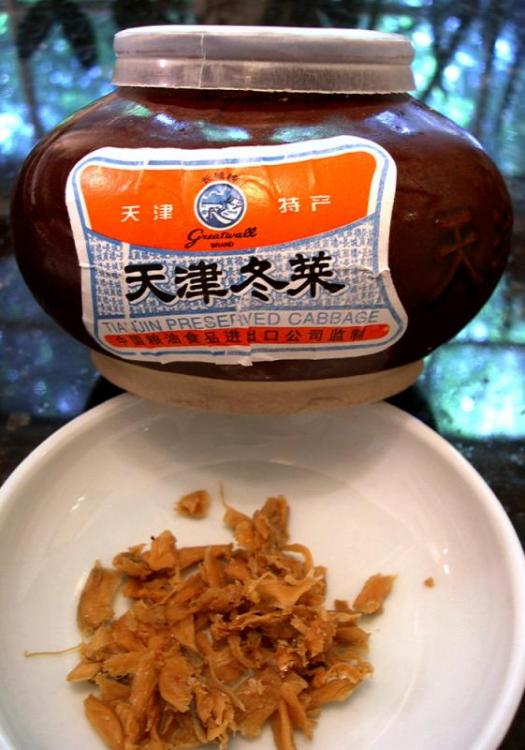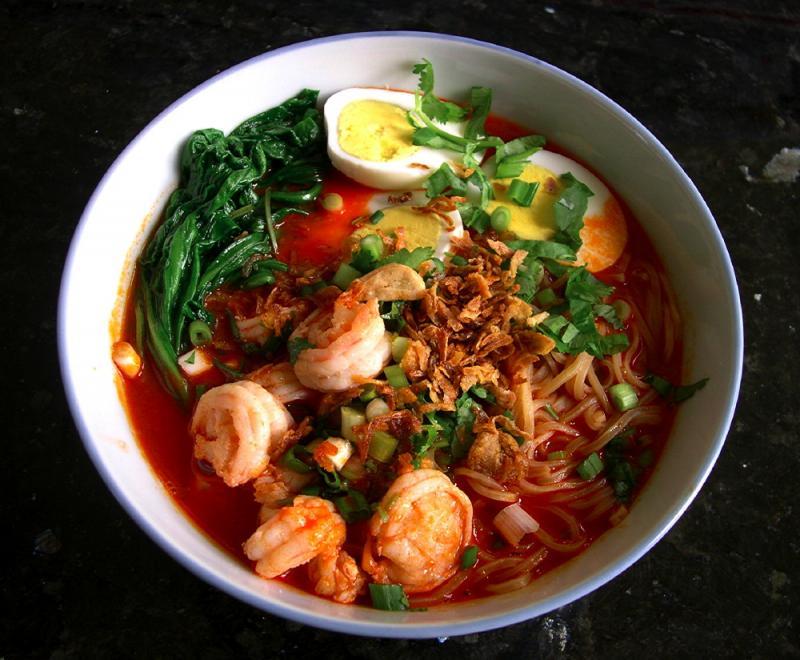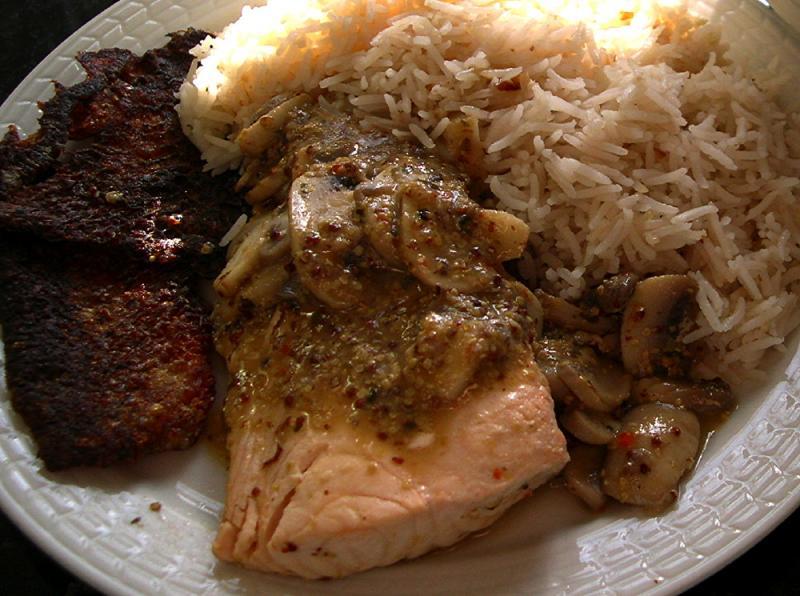-
Posts
3,810 -
Joined
-
Last visited
Content Type
Profiles
Forums
Store
Help Articles
Everything posted by huiray
-
Heh. That "Rice field eel congee" is interesting. :-)
-
TdeV, what you describe is closer to Teochew congee (except the rice grains would generally not be expanded like popcorn). Most versions of congee that I would expect would tend to have the liquid part definitely opaque/semi-opaque, with a fair bit to considerable body, for my taste anyway. Here's a pic of a batch of that pork spare rib congee I described above, from a few months back. (Cropped from a bigger picture, so less resolution than I would like). Also, a pic of that "Tung Choy" I mentioned, at higher resolution.
-
Lunch a few days ago: Sort-of "Penang Har Mee". Prawn stock w/ the shells and heads (w/ lots of head cream) from about 1 1/2 lbs of head-on shrimp sautéed w/ sambal terasi, shrimp paste w/ soy bean oil. The veggies were "Tong Ho" (edible chrysanthemum) and "Nga Choy" (mung bean sprouts), toppings were scallions, fried shallots, cilantro, halved hard boiled eggs, deveined shrimp sautéed in the pan (and retrieved before the shells etc went in for the stock). The noodle was a "Yee meen" analog.
-
Today, I had: • Salmon sort-of pan-fried/semi-poached with sliced mushrooms sautéed w/ a grainy mustard prepared by a local concern (and which has jalapenos in it). • The salmon skin (stripped off the piece of fish) separately pan-fried to nice browned crispy "chips". • Basmati rice briefly tossed w/ chopped garlic + finely sliced shallots being sautéed w/ peanut oil in my usual rice pot to which cardamom pods and bay leaves were added before the rice was dumped in, quenched w/ water plus a little salt and cooked as usual. • "Tong Ho" (Edible chrysanthemum leaves; broad-leaf variety) in chicken stock soup.
-
a.k.a. "fan chew" in Cantonese. An old, old "stuff" known in most rice-eating cuisines for however long the cuisine has been cooking rice, methinks. :-) The Chinese also cook rice with a melangé of stuff (meat + veggies + etc) in smallish clay pots [traditionally, preferably over charcoal fires] with a tight-fitting clay lid to give a wonderful meal-in-a-pot with very nice "fan chew" at the bottom. Some people push aside the rice & ingredients on top and get to the rice crust at the bottom first! https://www.google.com/search?q=clay+pot+rice&hl=en&client=firefox-a&hs=6Fg&tbo=u&rls=org.mozilla:en-US:official&tbm=isch&source=univ&sa=X&ei=foPKUJPUC8jVqQG7uYH4Dw&ved=0CDgQsAQ&biw=1274&bih=981
-
Glad it came out fine. Nevertheless, I would go along with what Keith_W said. I, too, am Cantonese and I would expect my congee ("jook"; 粥) to look like what he described. The "watery" version with separate rice grains floating in it is typical of Teochew (Chiu Chow; 潮州) "jook", amongst others. I normally start with a 1:8 ratio of uncooked rice to liquid and add more as needed. And, yes, I definitely concur with his comments about "overcooked" congee becoming just a pot of paste with no texture; as well as having to add more water when reheating leftovers. I would say it is not possible to reheat it *without* adding more water if one wishes to get a decent congee. Is there a reason why you wish to cook it so slowly for such a long time? If done on the stove top it takes just 1 to 1 1/2 hours to get a nice congee with nice texture. One variation I sometimes do is to sauté LOTS of finely julienned fresh ginger and maybe just a wee bit of smashed garlic till the ginger is just beginning to brown, add cut-up short-cut (against the bone) pork spare ribs with plus sea salt to taste, sauté until the mixture has lots of fond,* then add water/stock (8-10 parts) and simmer for maybe 1/2 hour or so. Raw rice** (1 part) is then added and the mixture stirred and simmered for somewhere between 1/2 to 1 hour more, depending on my mood and texture desire that day. Typically I would eat a bowl of this with chopped green onions, cilantro, "Tung Choy" (Tianjin preserved vegetables) and fried (browned, crispy) sliced shallots. * Sometimes I add in other stuff as well - e.g. "Ja Choy" (Preserved mustard stems; 榨菜) (Google it). It gets sautéed here with the meat. I think this would go well with shredded duck meat too. Preserved turnip is another addition that might be made. ** I tend to use long-grain (Basmati, even) rice for congee. I find that short-grain stuff gives too thick and gummy a result.
-
Not much more to add to the extensive lists of pet peeves about restaurant/bar experiences. Heh. Nevertheless, one thing that I haven't seen called out is making out at a table in the restaurant. I don't mean a quick caress or a simple kiss. I mean full-on snogging. I have seen this before and it was all I could do to repress the urge to go over to the table and tell them to "find a room". One particularly bad occurrence I observed was at a table in the middle of a (mid-range, Chinese) restaurant where said snogging was being conducted largely by a young lady who did not appear to be the wife of the gentleman diner who did not seem to mind the attentions being lavished on him. Ick.
-
This comment opens a big can of worms. There are plenty of people who when dining alone, like to dine at the bar. The bar is for drinking, I agree, but when it's in a restaurant, it's for eating too. A fairly recent development though, wouldn't you agree? For solo diners, I guess I see the point. Filling up the whole bar with eaters, as if it were an extension of the restaurant, really kills the vibe in most instances. A truly great restaurant would make a solo diner at a two-top feel at home. In France, it's never been a problem... and frequently been the rule. I'm not sure it's that recent a development. In the US it is a very common tactic, both willing and unwilling, and on either the part of the restaurant or the diner. In many cases the restaurant even refuses to seat solo diners except at the bar. I've had all sorts of experiences with dining-at-the-bar and/or dining-at-a-table in various places both high-end and mid- to low-end as I eat as a solo diner very frequently. I can see the issue from your point of view but in many cases your gripe should be with the management, not the diner. Solo diners at bars also run the whole range from sour-and-dour to lively conversationalists with others at the bar - so perhaps you may have only come across the sour-and-dour ones?
-
I would view it as proselytizing being forced on me. I don't have a choice to refuse the piece of paper on which this is written, I *have* to accept it (the check) and read it to settle my legal financial obligations with the dining establishment, as opposed to refusing the literature some corner evangelist or door-to-door Jehovah's Witness person tries to hand to me. Oh, don't forget that hamburger chain called In-n-Out...
-
...Or bartenders who don't understand what I mean (or refuse to remember) when I specifically request "stirred, not shaken". I've sent drinks back before (and gotten death stares) when I get a practically fizzy and completely opaque (with bubbles) Manhattan, for example, that's actually foamy on top.
-
Wow, that's pretty bad. Still, I think the "standing by the table waiting for your order" scenario is not uncommon in various Chinese cuisine type restaurants in SE Asia too, especially the more informal/"dai pai dong"/"dai chow" type of places. (Have you observed the same in other places in China?) At least at one time. The idea was that the server would answer questions you had while you read the menu (or looked at the menu on the walls) and would take your order as soon as possible etc. There were also places where there *wasn't* a formal menu as such and the server was the conduit to whatever was available that day. But, of course, that did not seem to be the case for you. Was this at a "high-end" place?
-
I wonder if people who have never eaten at, oh let's say Eleven Madison Park (and have not extensively researched it or read about its idiosyncrasies) would know exactly what to do when presented with the "menu" without another word from the server. http://eater.com/archives/2010/09/08/eleven-madison-parks-new-minimalist-menu.php http://willtravelforfood.com/2011/05/24/eleven-madison-park-new-york-restaurant/ http://www.mission-food.com/2012/04/eleven-madison-park-quintessential-new.html
-
Wow, I could have written that, your experience (including the drink ordered) and reaction would match mine *exactly* in various places!
-

The Death of Nahm – Are Government regulations killing genuine ethnic
huiray replied to a topic in Restaurant Life
My understanding is that there are Thai restaurants in Germany which serve dishes with authentic Thai ingredients, including stuff like Thai pea eggplants (Makua Puong มะเขือพวง) and other fresh stuff. I gathered from what a poster said on another forum that these ingredients were imported by the husband of one of the restauranteurs who appeared to also provide ingredients to other SE Asian restaurants too. If this is true, then it seems odd that such stuff cannot be brought into the UK too? Of course, perhaps some of the fresh stuff apparently available in Germany (as my understanding goes) might be cultivated somewhere locally but tropical-climate stuff might be a little difficult in Germany... -

Italian food vs. Italian-American food – differences?
huiray replied to a topic in Food Traditions & Culture
In addition to the comments about USAmericans tending towards going extra heavy with the cheese - another cheese-related difference is cheese with seafood in Italian-American food (and in the US), no cheese (with very rare exceptions) in Italian-Italian food (and in Italy). Relative cheese consumption with "Italian" dishes (note double quotation marks" in the US also strikes me as varying somewhat with the region too. When I moved from the Tristate area to the Midwest I was taken aback by the amount of cheese poured onto so-called "Italian" dishes (even more than I had noticed in a general sense previously) in all sorts of "Italian" places, which were, of course, more American-Italian places than something else. In my experience. It has been argued by some that cheese is such a typical and integral part of the food landscape in dairy-farming places like the Plains/Midwest that one should not be surprised by folks (speaking generally) desiring lots of cheese with everything. A generalization, of course. This extends even to things in other cuisines like "French Onion Soup", where a long-gone place here in my area used to serve this soup (highly regarded by the local food critic) which, to me, more resembled a crock of melted (and re-hardened) melted cheese with some bread and a vague hint of onion flavor. Heh. -

Italian food vs. Italian-American food – differences?
huiray replied to a topic in Food Traditions & Culture
Y'know, one could say all these three things about classic Cantonese cuisine too! -

Italian food vs. Italian-American food – differences?
huiray replied to a topic in Food Traditions & Culture
But you already did . The most important thing to know is that Italians will argue about food and the way it should be/is prepared, no matter if they're from the north, south, east or west. As a matter of fact, they will argue even in the same household! ...and things like tomatoes are more common in Southern/Central Italian cuisines, ditto dry pasta; more dairy and rice and fresh/formed pastas (e,g, ravioli) in Northern cuisines; etc etc. I knew some people (from the NY/CT/NJ area) who had meals in Venice who were completely surprised that the food there didn't have tomatoes. I heard the sentiment "Whoever heard of Italian food without tomatoes!" being expressed. :-) The "translated" cuisines in the US appear to ceratinly have regional aspects too - the NE immigrant population was heavy on the Southern/Sicilian heritage, whereas places like LA etc tend to be more Northern/Central Italian, I believe? I've certainly read narrations where someone in LA hosted guests visiting from the Tristate area who found Italian food in LA to be horrible - when what they really meant was that it wasn't the red-sauce type of Southern-derived Italian-American food they had come to expect. -
I thought there was a good case for CJ Jacobsen or Joshua Valentine to have been sent home instead of Chrissy Camba at the end of the latest episode.
-
I suppose they were expected to make classic French omelets, even though it wasn't spelled out and Wolfgang Puck merely asked them to make "an omelet" for him, and the comments about their being brown, sloppy etc would be meaningful in this sense. I wonder - suppose one of them (say, Chrissy Camba, drawing on her Filipino heritage and extrapolating into SE and E Asian fare) had made something like an oyster omelet ("Oh Chien" in Hokkien; https://www.google.com/search?q=oh+chien&ie=utf-8&oe=utf-8&aq=t&rls=org.mozilla:en-US:official&client=firefox-a) or Kuniko Yagi had made a form of "Tamagoyaki" instead? They're omelets - just not a *French* omelet.
-
D Magazine gave him that dubious title in cover story. I suppose he is most noted for taking over at the Mansion On Turtle Creek after Dean Fearing left, totally revamped the place, and won rave reviews. (he left RM Seafood in Las Vegas to take the gig). That didn't last long. But I think most of the hate comes from other chefs, cooks, waiters, etc. and restaurant owners, and probably less from the general public (though I suppose some hated that he changed the Mansion in a major way). He even gets mentioned by Anthony Bourdain in 'Kitchen Confidential'. Anyway... whole story is here. http://www.dmagazine...in_Dallas.aspx? John Tesar was "Jimmy Sears" in Bourdain's "Kitchen Confidential". One reads this-and-that about John Tesar's reputation in Dallas and elsewhere, and that dmagazine story wasn't exactly "neutral". Still, what did you hear the chefs, waiters, cooks etc say about Tesar , both good and bad?






